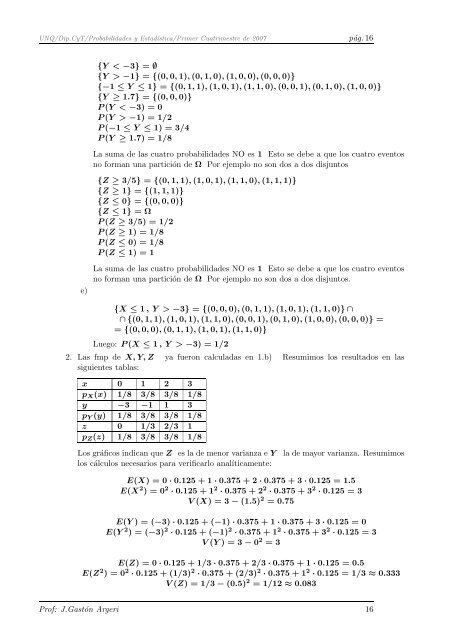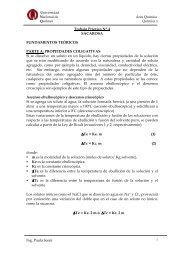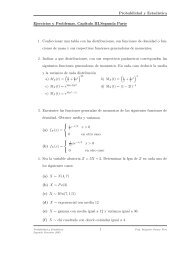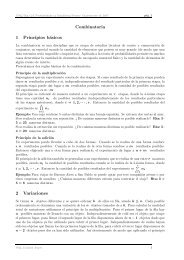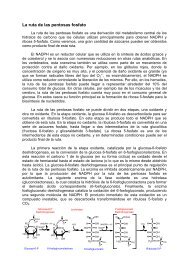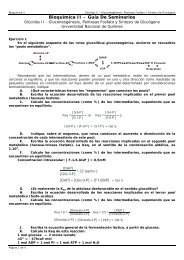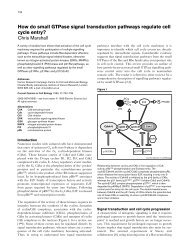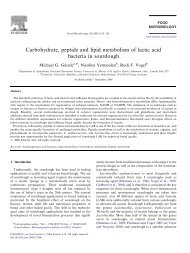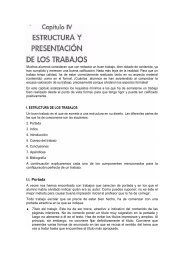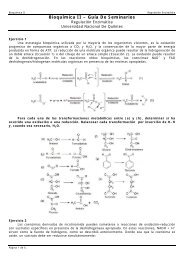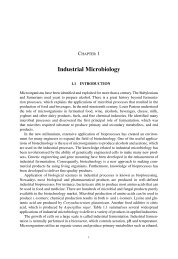Trabajo práctico 1: Combinatoria - Materias.unq.edu.ar
Trabajo práctico 1: Combinatoria - Materias.unq.edu.ar
Trabajo práctico 1: Combinatoria - Materias.unq.edu.ar
You also want an ePaper? Increase the reach of your titles
YUMPU automatically turns print PDFs into web optimized ePapers that Google loves.
UNQ/Dip.CyT/Probabilidades y Estadística/Primer Cuatrimestre de 2007 pág. 16<br />
{Y < −3} = ∅<br />
{Y > −1} = {(0, 0, 1), (0, 1, 0), (1, 0, 0), (0, 0, 0)}<br />
{−1 ≤ Y ≤ 1} = {(0, 1, 1), (1, 0, 1), (1, 1, 0), (0, 0, 1), (0, 1, 0), (1, 0, 0)}<br />
{Y ≥ 1.7} = {(0, 0, 0)}<br />
P (Y < −3) = 0<br />
P (Y > −1) = 1/2<br />
P (−1 ≤ Y ≤ 1) = 3/4<br />
P (Y ≥ 1.7) = 1/8<br />
La suma de las cuatro probabilidades NO es 1 Esto se debe a que los cuatro eventos<br />
no forman una p<strong>ar</strong>tición de Ω Por ejemplo no son dos a dos disjuntos<br />
{Z ≥ 3/5} = {(0, 1, 1), (1, 0, 1), (1, 1, 0), (1, 1, 1)}<br />
{Z ≥ 1} = {(1, 1, 1)}<br />
{Z ≤ 0} = {(0, 0, 0)}<br />
{Z ≤ 1} = Ω<br />
P (Z ≥ 3/5) = 1/2<br />
P (Z ≥ 1) = 1/8<br />
P (Z ≤ 0) = 1/8<br />
P (Z ≤ 1) = 1<br />
e)<br />
La suma de las cuatro probabilidades NO es 1 Esto se debe a que los cuatro eventos<br />
no forman una p<strong>ar</strong>tición de Ω Por ejemplo no son dos a dos disjuntos.<br />
{X ≤ 1 , Y > −3} = {(0, 0, 0), (0, 1, 1), (1, 0, 1), (1, 1, 0)} ∩<br />
∩ {(0, 1, 1), (1, 0, 1), (1, 1, 0), (0, 0, 1), (0, 1, 0), (1, 0, 0), (0, 0, 0)} =<br />
= {(0, 0, 0), (0, 1, 1), (1, 0, 1), (1, 1, 0)}<br />
Luego: P (X ≤ 1 , Y > −3) = 1/2<br />
2. Las fmp de X, Y, Z ya fueron calculadas en 1.b) Resumimos los resultados en las<br />
siguientes tablas:<br />
x 0 1 2 3<br />
p X (x) 1/8 3/8 3/8 1/8<br />
y −3 −1 1 3<br />
p Y (y) 1/8 3/8 3/8 1/8<br />
z 0 1/3 2/3 1<br />
p Z (z) 1/8 3/8 3/8 1/8<br />
Los gráficos indican que Z es la de menor v<strong>ar</strong>ianza e Y<br />
los cálculos neces<strong>ar</strong>ios p<strong>ar</strong>a verific<strong>ar</strong>lo analíticamente:<br />
la de mayor v<strong>ar</strong>ianza. Resumimos<br />
E(X) = 0 · 0.125 + 1 · 0.375 + 2 · 0.375 + 3 · 0.125 = 1.5<br />
E(X 2 ) = 0 2 · 0.125 + 1 2 · 0.375 + 2 2 · 0.375 + 3 2 · 0.125 = 3<br />
V (X) = 3 − (1.5) 2 = 0.75<br />
E(Y ) = (−3) · 0.125 + (−1) · 0.375 + 1 · 0.375 + 3 · 0.125 = 0<br />
E(Y 2 ) = (−3) 2 · 0.125 + (−1) 2 · 0.375 + 1 2 · 0.375 + 3 2 · 0.125 = 3<br />
V (Y ) = 3 − 0 2 = 3<br />
E(Z) = 0 · 0.125 + 1/3 · 0.375 + 2/3 · 0.375 + 1 · 0.125 = 0.5<br />
E(Z 2 ) = 0 2 · 0.125 + (1/3) 2 · 0.375 + (2/3) 2 · 0.375 + 1 2 · 0.125 = 1/3 ≈ 0.333<br />
V (Z) = 1/3 − (0.5) 2 = 1/12 ≈ 0.083<br />
Prof: J.Gastón Argeri 16


